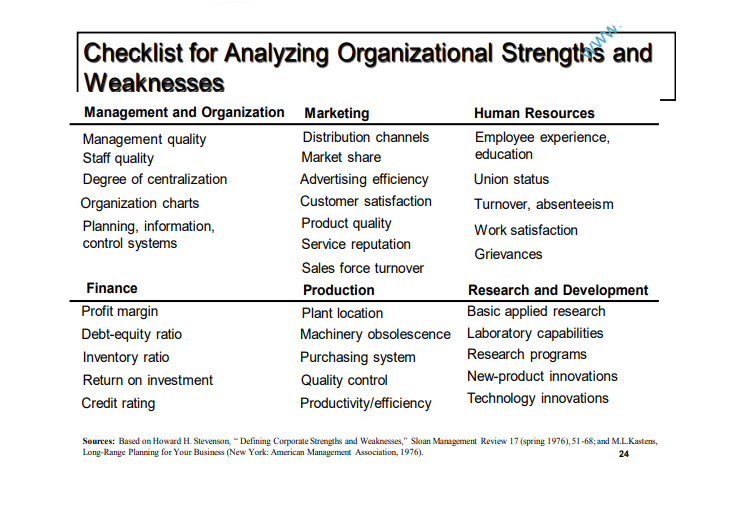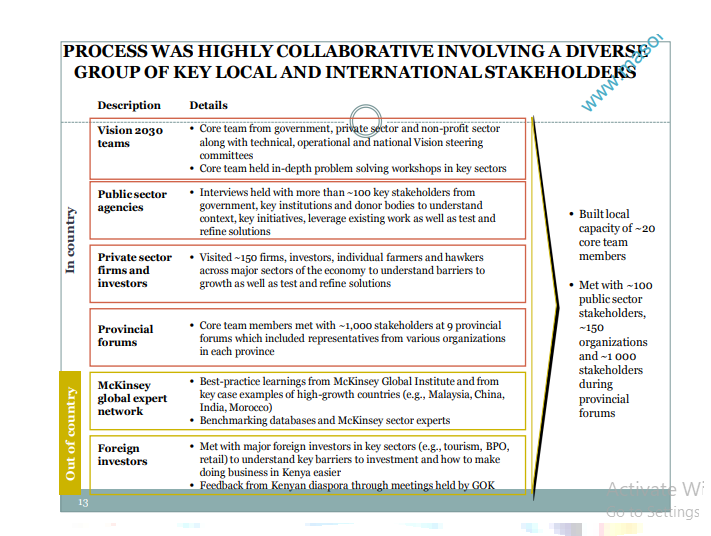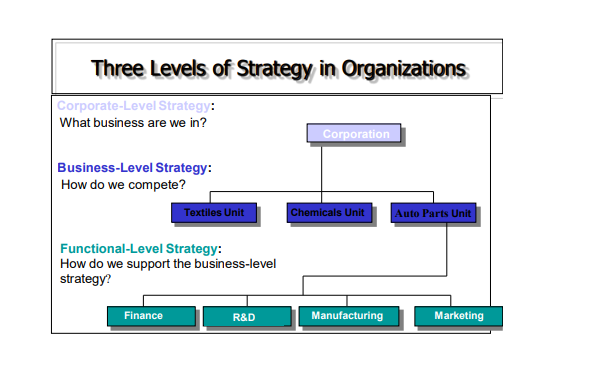Strategy Formulation is designed to guide executives in defining the business, their company, the aims it seeks, and the means it uses to accomplish these aims. Strategy formulation involves an improved approach to traditional long-range planning. Strategy formulation joins a future oriented perspective with concern for firm’s internal and external environment in developing its
competitive planning action. Thus the Process of using environmental analysis in strategy formulation is significant. Strategy formulation will always follows the same steps regardless of level; however, the scope will differ. Environmental analysis either formal or informal plays significant role in strategy formulation. Infact, environmental analysis plays the most important input for strategy formulation because an organization tries to relate itself to the demand of the environment. Therefore, managers should ensure that their function of environment analysis is integrated with strategy formulation. The various steps involved in this context can be described as follows.
• Study of the Environment. Every organization undertakes analysis of environment either on formal basis or informal basis depending on the size of the organisation, its managerial philosophy, the nature of its environment, etc. However, if environmental
analysis is taken as on-going basis, it serves the organizational purpose in a much better way. Moreover, on-going environment study takes much wider coverage of the environment. When art analysis is limited to specific projects, it covers only some area in the environment having behind spots in others. An on-going study can locate existing and potential impact oi the environment on the organization. This phase is to be directed by and is complementary to the phase of informal planning. It should aim at broad
coverage of the environment rather. This serves two purposes:-
- it becomes complementary source for identifying perceived environmental causes for the changes in strategy;
- its output may serve as a trigger for strategy changes for detailed environmental analysis.
• Perceived Environmental Causes for Strategy Change. Strategy makers perceive the need for strategy change in the light of environmental factors. This awareness of environmental forces and their impact on the organization does not come suddenly.
Moreover, this awareness fluctuates over the period of time. However, this alone does not initiate strategy changes.
• The trigger is an event or set of events that initiates strategy changes or creates need for environmental data. Events serving in triggers may take place outside the organization, e.g., a change in the Government’s policy toward foreign technical collaboration of entry of new competitor with some unique features; or may take place within the organization, e.g., change in organizational structure or during of a new key executive. In fact, various triggers outside the organization force managers to take environmental studies on specific project basis. For example, Reliance Industries even took the study of application of Government oi India’s decision of not withdrawing Rs. 1100 core of its loan sanctioned by International Monetary Fund. Though such a study was not related with the immediate business of the company, this could provide way for evaluation of the business opportunities lying in the environment.
• Strategy Changes. These Triggers may be used as a means of Strategy changes. However, strategy changes based on triggers alone may be. It gives right direction for strategy change but triggers must be used as the reasons for collecting appropriate information
from the environment.
• Need for Environmental Data. Need for environmental data because of two f actors first, the organization is taking, up environmental analysis as an on-going process and second, when some triggers are there. While the first aspect emphasizes the general study of the
environment, the second emphasizes on specific project or areas to be studied.
• Assignment of Environmental Study Project. The assignment of environmental study project depends on the organization and its practice of environmental study. If it is monitoring the environment on continuous basis and some persons are assigned for this
purpose, these persons can take up this job as an additional work load, if the organisation does‘ not have a special task force which can be created for the purpose which may be termed as environmental analysis unit (EAU). The task between EAU and strategists
could be clearly shown so that exact term of reference can be fixed.
• Collection and Analysis of Data. Data collection at this stage may be specific relating to the particular strategy which an organization may consider seriously looking into various aspects, such of all those factors which go into choice of strategy. However, data
collection and analysis cannot be taken just to satisfy a strategy information based on whims of some people at the top level of the organization.
• Preparation of Reports and Presentation to Strategy Makers. The complete report can be presented to those people who can make decision on it. Usually most of the organizations have certain .specified groups of people who make strategic decision. However, they can perform better if they work in close contact with people responsible for planning of environment.
• Indirect Impact. External environmental scanning is only one end of input which goes in strategy formulation. Therefore, strategy may not necessary go on the basis of report prepared by environmental scanning group. However, they are affected by the information inputs. Therefore, environmental scanning can stimulate them indirectly to go for certain strategy. Thus, more frequent exposure of the strategy maker to data and its analysis will enhance the educational process which is the essence of the indirect impact. The additional exposure can be achieved through periodical progress reports.
• Translation of Environmental Analysis Into Strategy Action. Direct use of environmental analysis in strategy making requires translation of environmental analysis in strategy making which requires translation of environmental analysis into specific changes. When large amount of data is collected and analyzed, either strategy makers cart make decisions leading to strategic change or they may create special task force whose task may be to make environmental analysis. Effective translation of environmental analysis in to
specific change can be performed cooperatively by analysts, strategy makers, and task force if created.
Factors Affecting use of Environmental analysis in Strategy Formulation
• Managerial Philosophy. The managerial philosophy determines the actions which managers take towards various factors affecting their decisions. Such factors may include the environmental forces as well as the various internal forces. If the managerial philosophy is positive, the managers are likely to take into account the various factors affecting the organization while making decisions.
• The term managerial philosophy includes manager’s attitudes, reactions to situations, and the way of looking at the things. If these are positive, they may go for long-term actions for which they require more information about the environment. From this point of view, managers can be classified into two categories’ those who are forward- locking and those who keep themselves busy in the day-to-day affairs of the organization. It is the latter category of managers who do not put great emphasis on the environmental search and
analysis. They lead stagnant organization. They focus on a very narrow range of the environment and tend to over-emphasize details instead of focusing on the long-term impact and leaving the details of their subordinates. They feel more satisfied by the past
and present performance of their organization rather than looking into the future. Sometime even the internal environment of the organization may compel to believe so.
For example, the reward and punishment system of the organization may emphasize on the present performance rather than on the long-term planning which may modify the manager’s thinking to look into the present. Then tries are managers who believe that take
care of present, future will take care of its own. Naturally the range of environmental analysis for such managers is limited.
• On the other hand, forward-looking managers think of future keeping in mind the happening in the present. They look for various opportunities in the environment. They believe that opportunities knocks the door for once. If you miss this, you miss for ever.
Naturally such managers will be more conscious about what is happening outside their organizations. For this purpose, they go for seeking maximum information from the environment. Thus the managerial philosophy determines the volume and type of information that manager will seek from the environment. However, it can be mentioned, that if a top level manager is not spending his 15-20 per cent time on strategic management and interacting with the environment, he is certainly leading to slow death
of his organization.
• Age of the Organization. The age of the organization may also determine the type of information that can be sought by it, the organizational growth over the period of time requires different type of interaction with its environment. Generally older is the age of
the organization with the more experienced managers, the narrower will be the focus on the environmental ‘ information because with the experience, manager may be able to distinguish either what is relevant or irrelevant of the organization. The necessary information may be sought and unnecessary will be screened out. Since the information can be tested to determine the organizational effectiveness by the managers, they can easily know the relevance of a particular piece of information.
• Size and Power of the Organisation. Size is an important factor (or determining the interaction with the environment. Normally larger is the size of the organisation, more will be its interaction with its environment. When an organisation is small, it may be
exempted Irom various legal provision, with regard to its various management practice. For example, the various labour legislation are applicable only when the organisation has achieved a certain size. Similarly, the organisation is covered by MRTP Act or Industries
(Development and Regulation) Act after it has achieved certain size.
• The relative power of the organisation vis-a-vis its external environment determines the extent to which the organisation can control or is controlled by the environmental forces. If the organisation is strong in respect of certain environmental factors, it is unlikely to
focus attention on this aspect.

Formulation of a corporate strategy should be collaborative
A strategy should be participatory in the sense that all stakeholder s are involved. At global level, this happened in Singapore and Malaysia. Locally the country‘s blue print was equally collaborative as shown below.

The strategy should have a time frame. A local example is Kenya‘s national time frame as shown below:-

Business strategy
Business Level: Strategic Business Unit (SBU) managers (e.g.. Divisional General Managers), are involved at this level in taking strategic decisions. Here” strategies are about how to compete in particular product-markets. The strategies are related to a unit within the organization. On this point it also important to mention operating level strategy. This third level of strategy is at the operating end of the organization. Here, the strategies are concerned with how the different functions of the enterprise like marketing, finance, manufacturing, etc. contribute to the strategies of other levels. These contributions are important in terms of how can an organization become competitive. Competitive strategy depends to a large extent on decisions about market entry, price, product offer, financing, manpower, investment in plant, etc. In themselves these decisions are of strategic importance but are made, or at least strongly influenced at operational levels.
ELEMENTS
Strategic Management is concerned with deciding on the strategy and how the strategy is to be put into action. Strategic management has three main elements: strategic analysis, strategic choice, and strategy Implementation.
Strategic Analysis: This is concerned with understanding the strategic situation of the organization and its effects on the organization, assessment of its resources and strengths in the context of these changes, effect of the changes on people and on their present and future aspirations.
Strategic Choice: Strategic analysis provides a basis for strategic choice. This is concerned with the formulation of possible courses of action, their evaluation and the choice between them. This means that the strategic choice has three parts to it- generation of strategic options, evaluation ct strategic options and selection of strategy.
Strategy Implementation: This is concerned with translation of general directions of strategy into action. This is also as important as strategic analysis and choice. Implementation involves resources planning in which logistics of implementation are examined. It also takes into account the organization structure needed to carry through the strategy and of course the systems and people who implement the strategy are important.
